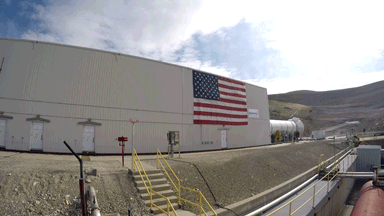SLS Accelerator Final Tests: Live Broadcast

Today, NASA's general contractor, Orbital ATK, at the test site in Promontory (Utah) will conduct a second and final test of the launch accelerator of the future Space Launch System (SLS) super-heavy rocket , the largest solid fuel accelerator ever built.
The live broadcast on NASA Television channel starts at 16:30 Moscow time. Directly the beginning is scheduled for 17:05 Moscow time.
UPD 1. Tests transferred to 18:05 Moscow time due to a computer breakdown .
Today’s official test, entitled “Static Engine Qualification Test 2” (QM-2), will help collect the latest critical data that are needed to allow a missile to be tested. If everything goes well, the first test flight of the SLS rocket will take place at the end of 2018.
The June 28 test may last just a couple of minutes, but preparation for it took several months .
In April and May, segments filled with rocket fuel began to be driven to the Orbital ATK Test Bay T-97 test site. The new accelerators were created on the basis of space shuttle accelerators “Space Shuttle”, but they have been significantly upgraded, and their power has been increased due to the additional fifth fuel segment. Unlike the Shuttle, SLS accelerators are planned as disposable.
Many of these segments can be called space flight veterans. In fact, some segments of the QM-2 already participated in 48 launches of the Space Shuttle space shuttle.
SLS solid fuel boosters - the largest and most powerful of all ever created, after the Aerojet AJ-260 SL-1 and SL-2released in the 60s for the lunar program. According to specialists, up to 75% of the acceleration of the rocket at the start will be given by the work of accelerators, each of which in length reaches about 47 meters.

Launch of a launch vehicle with solid-fuel boosters and the Discovery shuttle. Photo: NASA
Two weeks ago, Orbital ATK engineers began conducting tests on individual systems (without igniting the fuel) to verify that all cables, systems and modules were in good condition before testing on 28 June.
There are a lot of cameras around the test site, which on June 28 at 5:05 pm Moscow time, will shoot the ignition of fuel from all angles. For example, below is a frame of one of the chambers that monitors the behavior of the plugs (membranes) of the nozzle of a solid fuel engine during the first tests in March 2015.

Today, specialists need to collect data on 82 test tasks - all information goes to the control bunker near the test site.
At 11:00 MSK, Orbital ATK engineers made the final decision to carry out the test (weather conditions should be suitable: moderate wind, no thunderstorms and lightning discharges). Technicians rolled back from the accelerator a special mobile protective case and prepared a massive engine for launch.

These minutes end checking all video cameras around the landfill, as well as computer systems for recording data.
At 14:30, an observation deck opened in Promontory near Highway 83, people began to be let in there. Employees of the aerospace company are helped by the Utah traffic police: according to the organizers, approximately 10,000 spectators will be able to see live at the tests of the world's largest rocket.
At 16:05, the countdown starts before the start, the public broadcasting system starts, and the engineers complete the last procedures.
At 5:01 pm, the public broadcasting system will make an official announcement about the start of the test.
At 17:04 a siren will begin to roar, which will shut up 20 seconds before launch.
45 seconds before launch, the “Safe and Arm” command sequence is activated, which remotely puts the engine into a state of readiness for igniting the fuel on command.
Exactly at 5:05 pm Moscow time, ignition occurs. The giant accelerator will begin to spew streams of flame in about two minutes. Every second burns five and a half tons of rocket fuel.

At the end of the test, two five-segment accelerators and four main RS-25 engines will be part of the largest SLS rocket that NASA plans to use for the most important manned missions, including the delivery of the Orion spacecraft with the crew to Mars.

During its first test flight , the Orion spaceship without a crew will overtake the Moon and return in about three weeks.
The live test broadcast on NASA Television channel begins on June 28 at 16:30 Moscow time.
UPD 2. The tests were successful .


The press conference on the results is scheduled for 19:00 Moscow time.
UPD 3. Published test video .
